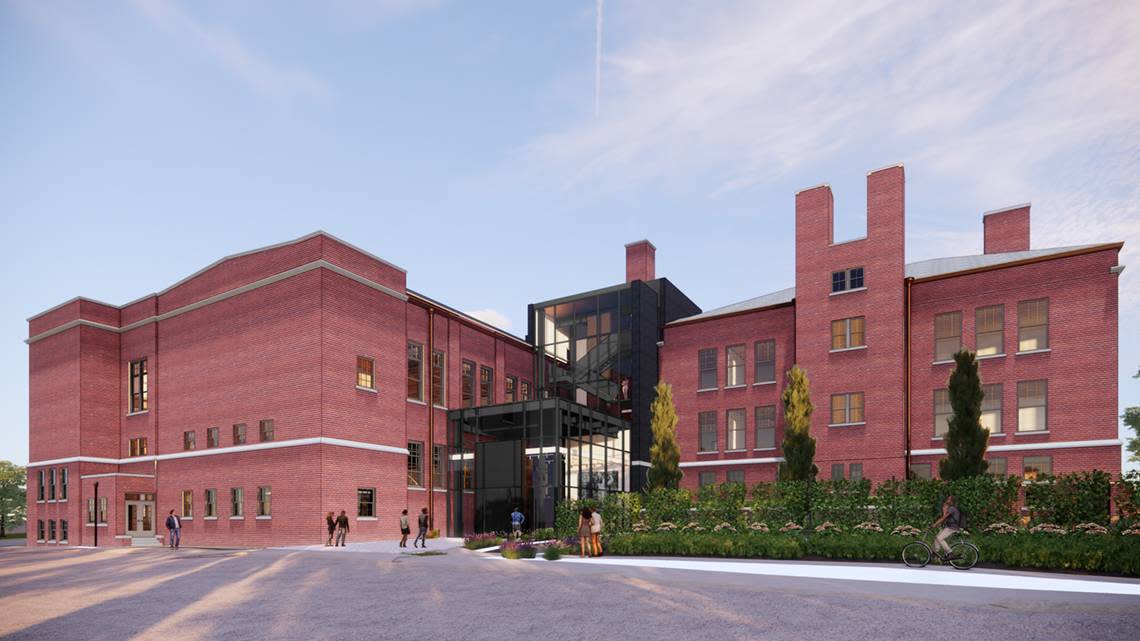These artists are building toward a new cultural legacy at Kansas City’s 18th & Vine
The Zhou brothers, DaHuang and ShanZuo, have an undeniably cool style: fedoras and dark shades, each dressed starkly in black and white — a look you’d expect from world-renowned contemporary artists.
I met them last week at a restaurant in Kansas City’s historic 18th & Vine Jazz District. They stood with me on the northwest corner of the intersection and pointed east.
In a year, they said, the second Zhou B Art Center in the world will open just blocks from where we stood. In their vision, artists from around the country, the world even, will flock to Kansas City to live, learn and exhibit art in a space with studios, performance, exhibition and gathering areas. As they talked, I could almost hear and see the district bustling with shoppers and sightseers.
The Zhou brothers opened their first center nearly 20 years ago in Chicago, their home base, and transformed that city’s Bridgeport neighborhood — formerly an Irish working class community on the city’s South Side — into a thriving, diverse art district and tourist destination.
They plan to bring the concept to Kansas City. It’s an exciting proposition that no doubt could reinvigorate the area that was once — in the 1920s, ‘30s and ‘40s — the heartbeat of jazz and culture for Black Kansas Citians and the epicenter of the city’s Black business district.
In recent years, the neighborhood has struggled to thrive, even as the attractions of the American Jazz and Negro Leagues Baseball museums remain its cornerstones, and several jazz clubs and Black-owned businesses have found homes there.
From 1990 to 2016, the city spent about $100 million trying to revitalize the district, including supporting the museums, the Gregg/Klice Community Center, the Jazz Commission, the Black Archives, the Gem Theater and the annual Juneteenth celebration.
In the fall of 2016, DaHuang came to Kansas City to visit longtime friend Allan Gray, now a partner in the brothers’ Kansas City project. On his way back to the airport, he made one last stop to tour 18th and Vine. That’s when he first saw the historic but long-vacant Attucks School, named for Crispus Attucks, a Black man killed in the Boston Massacre in the lead-up to the Revolutionary War. The school started in 1905 for Black children, but in recent times was reduced to decay after years of neglect.
DaHuang immediately envisioned the old, two-story brick building would be perfect for another Zhou B Art Center. “It was just a feeling. I didn’t know anything really about the history of the building or the 18th and Vine area,” he said. “But I had a feeling.”

The brothers purchased the building from the city and negotiated a deal that includes tax incentives and federal money. It’s exactly the kind of historical preservation project intended for tax incentives, said Mayor Quinton Lucas, who has lived a few blocks from the historic Attucks school.
“That building had become an eyesore,” Lucas said, “I think there has always been hope that we would find use for that building. This is a regenerating project.”
Bob Kendrick, president of the Negro Leagues Baseball Museum, said “the historic district is on the cusp of just taking off and I’m optimistic.”
Optimism is good. But no one, including me, wants to see the neighborhood become another gentrification nightmare that prices out those who have lived in its surrounding neighborhoods for decades.
City, civic and community leaders can ill afford to allow that to happen. What has made the district so special is its legacy, rooted in the history of Black Kansas City, and that should never change.
“My hope is that we build something that stays with the culture and character that is 18th and Vine,” said Lucas. “Something that attracts Black developers and more minority businesses.”
Hear, hear. I join others in the excitement about what’s happening in the historic district. This revival must try to preserve affordable housing space for those who’ve lived in the area for decades while also incorporating the revolutionary spirit of artists like Charlie Parker, whose cool blues enlivened the area in its heyday.
